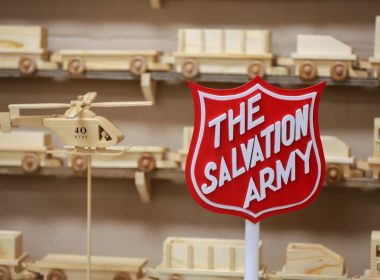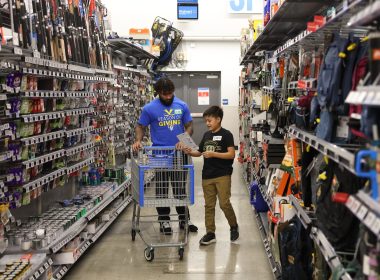Doing the Most Good in Southern California
by Sue Schumann Warner –
Southern California Divisional Leaders Majors Paul and Carol Seiler read to children at the LA Red Shield. Photo by Kamara Sams Holden |
In downtown Los Angeles’ gritty industrial neighborhood—filled with aging warehouses and bordered by Skid Row and the garment district—where whole families survive on piece work wages (two cents and four cents a piece—six cents for a shoulder pad) and signs are splashed in Spanish—The Salvation Army’s Los Angeles Day Care Center sits squarely on a city block…welcoming children whose parents work nearby, and providing quality pre-school and after-school care for nearly 250 children. It is one of the largest and oldest day care programs in the city.
Director Sara Varela oversees the center, with its operating budget of over $1 million—$600,000 of which comes from state and federal assistance—which provides caring, supportive services for struggling families, many of whom are immigrants.
It is one of the many ways in which the Southern California Division is doing the most good.
“I believe doing the most good means doing The Salvation Army the way it should be done,” said Major Paul Seiler, who with his wife, Major Carol Seiler, are divisional leaders. “It reflects the holistic ministry—meeting spiritual and physical needs.”
Elsewhere in the division, which encompasses all of Los Angeles and Orange Counties, and four corps to the north: Ventura, Santa Barbara, Oxnard and Santa Maria, Salvationists hold to that ideal:
• Santa Ana Temple Corps soldiers conduct 8-10 mobile Sunday schools in the barrios.
• Bell Shelter provides emergency shelter, skills acquisition, transitional housing, substance abuse recovery, mental health assessment and treatment, counseling, and chapel services for 350 men and women.
• Camps Mt. Crags and Gilmore offer summer camps with nature study, crafts, sports, and music to over 2,000 youth each year; many from low-income families.
• The Way In Youth Shelter & Drop-In Center, in Hollywood, provides a residential program for homeless youth.
• Six Adult Rehabilitation Centers, under the ARC Command and funded by revenue from 54 area thrift stores, provide residential work therapy, counseling and spiritual guidance for recovering substance abusers. Each ARC has a good relationship with the local corps.
Unique challenges
Within Los Angeles County, there are 40-50,000 non-profit organizations competing for funding—including The Salvation Army. Of the division’s $67 plus million annual operating budget, $24 million comes from contributions (including kettles, mail appeal and tithing), $19 million from government funding, $9 million from program services fees and the rest from other sources including United Way.
“We’ve worked hard this past year in dealing with divisional debt,” said Seiler. “We want to put our resources where they get the best return on investment.” He mentions the closing of the Booth Memorial Center, which opened in 1899 and originally served as a home for unwed mothers, as one example. “Over the years, the center shifted its focus to serve as a licensed group home to equip parenting teens and emotionally disturbed adolescent girls with the tools they needed to live independently. We had 25-30 girls who were in great need. It was a huge financial investment, and even with that it was losing money. It was a realignment we felt we needed to make as the trend is also moving away from large group homes.”
Corps restructuring is another example. A number of corps with parallel programs and officers (one English and one non-English speaking), had costs lessened by “reducing” an officer couple and merging administrative responsibilities. At the Redondo Beach Corps, which has English and Brazilian (Portuguese-speaking) congregations, Brazilian officers Captains Isais and Adela Braggas now provide primary leadership. Majors Chuck and Linda Gillies lead the English services at this location.. “We’re the ethnic corps,” explains Gillies, who also provides coordinating and mentoring support for several corps in the area.
Leadership training
Seiler notes two new programs providing additional skills and planning tools to officers. One, the Leadership Learning Lab, is held twice a month near divisional headquarters. “Both directors and officers attend and receive training in areas which they’ve requested: from human resource issues to finances to Christmas kettle training.”
The most critical new program is SOAP: Strategic Organizational Accountability Process. Starting last fall, instead of having traditional corps reviews, a team of five officers and employees drawn from DHQ and other corps (in the fields of PR/fundraising, business/finance, social services, adult programs, and youth programs) visited corps to meet with the officers and develop goals and action steps. Each quarter the corps will be revisited by their SOAP team to review the goals and ensure they are being met. A key element is the mutual accountability agreed to in the action steps.
“In this division, one of the indicators of doing the most good is building healthy corps congregations,” Seiler said. “They are the key to the future of The Salvation Army.”
The “Tab” and LA Korean Corps ‘do more than church’
Each Saturday morning, you’ll find 12-15 soldiers from the Pasadena Tabernacle Corps out at Memorial Park, providing food and spiritual support to the homeless who congregate there. “It started a year ago,” said Corps Officer Captain Edward Hill, who serves with his wife Captain Shelly Hill. “It was the missing piece in our ministry; we weren’t going into the community to meet the needs of the poor.” The corps purchases food from the ARC and feeds between 75 to 125 people. In addition, they hold a short open-air meeting and pray for those who ask; at times, they distribute hygiene kits and blankets.
Soldiers from the LA Korean Corps, under the leadership of Captains Jong-sun and In-ok Kim, go out on Friday nights to feed the homeless as well. Captain Jong-sun Kim extends the Army’s ministry with a program in Korean on Channel 44 at 7:50 p.m. on Fridays. “We get phone calls almost daily due to the program,” he said.
Red Shield: it’s all about relationships
Under the leadership of Red Shield Director Irene de Anda Lewis, the Los Angeles Red Shield has developed strong relationships with the inner city community and with corporate sponsors. “People tell me, ‘You always come through for us,’” said Lewis. “That’s what it’s all about for kids, for families, and for donors.” That attitude resulted in a recent $247,000 donation of Field Turf for the center’s soccer field. “Nike gave $37,000, the U.S. Soccer Foundation gave $100,000 and HUD provided a matching grant of $100,000. An additional grant of $10,000 came from City Councilman Ed Reyes to help with the field’s security by replacing an old 8 foot fence with a new 14 foot fence.” As a result, over 600 children play soccer at the center, with leagues for all ages—and that’s in addition to the 3,5000 plus children and families who enjoy the pool, ballet academy, children’s theater, computer lab, basketball program, and other activities.
South LA Center for Worship and Service
Located at 7651 South Central Ave.—right on the dividing line between the turfs of the rival Crips and Bloods gangs, the center first began as a mobile project, visiting neighborhoods with before and after school programs. Now, under the leadership of Director Mortimer Jones, the 37,000-square-foot center hosts after school programs for youth and teens, including computer literacy, sports, arts, and a skate park, as well as a licensed childcare center and charter school. Teen court makes use of the center as well, with actual juvenile court cases tried before a judge and jury.
Social services: living with dignity
“The strength of our social services lies in our holistic ministry approach,” said Steve Allen, Los Angeles metro social services director. “In all of our programs we’re blessed with committed and passionate staff, who genuinely care for the individuals we serve. We continually strive for high standards of program excellence, which is complimented by a strong ministry focus.”
Clearly, the division’s transitional and rehabilitation programs reflect that commitment.
The Harbor Light’s “front line” ministry in the heart of Skid Row serves up to 212 men with a residential rehabilitation and substance abuse recovery program. It also serves meals to 75-150 homeless each day, 365 days a year. “We’ve got a sound program with a strong spiritual emphasis,” said Administrator Conrad Watson, himself a Harbor Light graduate. “It is a radical commitment. They don’t complete the program successfully unless they leave with employment and housing—we teach people how to get employment and still tell the truth [about their past].”
Across the street the women’s Safe Harbor Center, under the direction of Captain Tolani Finley, provides a residential substance abuse recovery program for up to 56 women. Women living on Skid Row can also drop in for services.
Nestled next to the 405 Freeway, the Westwood Transitional Living Center provides 41 apartment units for families, with 10 units for veterans, who may stay for up to two years while they stabilize and obtain skills for independent living. Executive Director Estella Wilson notes that The UCLA School of Medicine and Dentistry clinic provides care every two weeks for the children. “All of the teachers at the on-site nursery school are licensed child care providers,” she added.
The Haven, located on the West Los Angeles Veterans Administration complex, serves 2,500 veterans each year. Lt. Roy Snapp-Kolas, program director, notes that programs address the varied needs of veterans: substance abuse, emergency housing, mentally ill (board and care), senior veterans; there is also a program for women. “Veterans receive help here and get on with life,” he said.
Tucked away in the Silverlake district of Los Angeles, a tranquil community named Alegria provides housing for 44 low-income families affected by AIDS; 28 of the units are for transitional housing. A childcare center licensed for 68 is also onsite. “People with AIDS are living longer,” said Executive Director Jeff Lane. “That’s one reason why we have Alegria.”
Corps continue to meet needs
The Salvation Army has been serving the community of Pomona since 1888. “We’re a good fit,” said Corps Officer Captain Ken Perine. “We try to help the whole person.” That includes a family services ministry whose staff is trained to be attentive to the individual, not just their immediate physical need, and soldiers who regularly drop by the corps to make food baskets or talk with people in the lobby. A number of parents whose children attend the preschool now call the Army their church home. “Our holistic ministry drives the rest,” Perine noted. Captain Jen Perine serves with her husband as corps officer.
Captains Hector and Ana Diaz are corps officers at the East Los Angeles Corps, home to a Spanish-speaking congregation. In a low-income community with no food bank and few support systems, The Salvation Army provides practical assistance to those in need. “Everyone knows us here,” said Diaz. Some of that help is in the form of vouchers or tokens for transportation by bus or taxi to medical appointments. In addition, the corps has a strong spiritual ministry, including Bible study, prayer meetings, visitation, Home League, men’s club and youth programs.
Over at the Anaheim Corps and Red Shield, housed in a former YMCA facility, youth of all ages enjoy Army programs and activities. Corps Officers Captains James and Beverley Lloyd report a growing congregation—a number of whom are ARC beneficiaries and graduates and their families—and enthusiastic young participants in the school of music. Community care is also a priority. “We love to take the children from the corps to the nursing home,” said Lloyd.
The Red Shield offers a host of after school programs including swimming, basketball, and homework time, plus academic classes for ‘off track’ students who attend year round schools. “When you see the effect the Red Shield has on gangs, the graduation rate, and the crime rate, it’s amazing,” said Administrator Kevin White. “If we can help the kids, we might have less need for adult programs later on.”
The largest Hispanic corps in the division, Santa Ana Temple Corps, sits on a 15-acre site that is home to a corps, English classes, youth center, soccer field, and much more. Majors Louis and Maria Martinez, corps officers, provide oversight to the facility. A popular after school program provides homework and computer labs to nearly 90 youth each day; summer camp is filled with outings, learning time, and chapel. “We provide a safe environment for the kids,” said Melanie Bartlett, director. “Without this, they would be out on the streets.”
The corps is busy all week long: Family night on Fridays; mobile outreach on Tuesday nights to the barrio; on Sundays, soldiers bring child evangelism to three different sites in the morning and two in the afternoon in addition to traditional morning chapel services; home Bible studies continue during the week.
Doing good with what we have
“The Southern California Division is doing a lot with limited resources,” said Divisional Secretary for Program Major Steve Smith. “Our officers–especially from the nontraditional corps—are really branching out into the communities.” He noted the Bellflower Temple Corps has started a senior drop-in center, an emergency food pantry, and even provided a Spanish speaking couple to volunteer at the Whittier Corps. “Now, 75 attend church there on Sunday afternoon,” said Smith.
Just one of the many places in which solders, officers, and employees of the Southern California Division are doing the most good.










